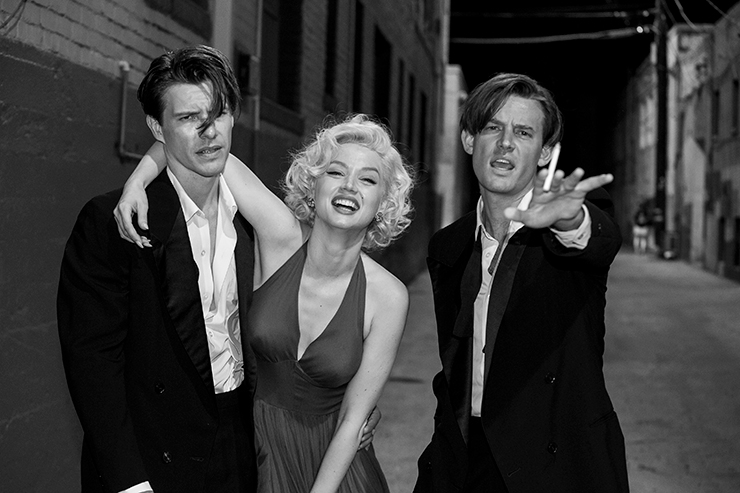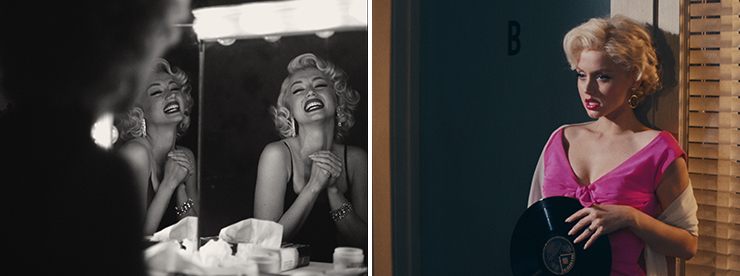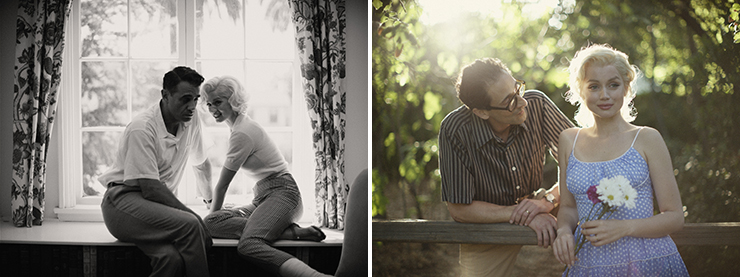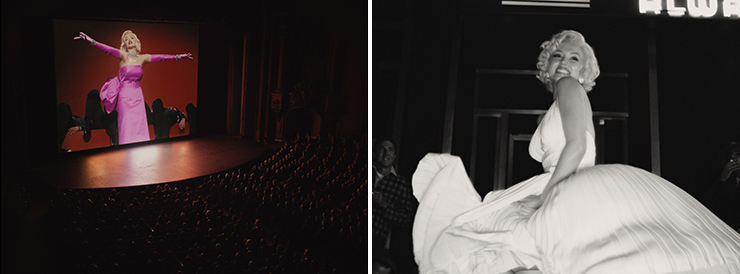
Xavier Samuels, Ana de Armas and Evan Williams in a scene from "Blonde." Photo credit: Netflix © 2022.
The Los Angeles sky is dotted with stars, and Marilyn Monroe looks up, her eyes widening in wonder.
“Look at them up there, shining so brightly. And yet, each one is so very much alone,” she says in that breathy childlike voice that's instantly recognizable by cinephiles and most movie newbies alike.
It's nighttime in Tinseltown, in more ways than one, in “Blonde,” a film that's at once starstruck by the iconic bombshell and dead set on dragging her through the mud so we feel the excruciating pain she endured throughout her life.
It's highly unlikely this brief epiphany, one of several in a movie that never gets tired of gazing at its subjects from all of kinds of different angles, happened in real life, and director Andrew Dominik makes it clear from the outset that he's adapting a work of fiction. In bringing novelist Joyce Carol Oates' best-seller to the screen, he aims to use creative license, a lot of it, in order to attain the kinds of truths that biographies and documentaries can barely hint at. He doesn't fully succeed, but the gripping results still grabbed this critic by the lapels through most of its hefty running time.

Ana de Armas in a scene from "Blonde." Photo credit: Netflix © 2022.
It's tricky to recommend a film that alternates between moments of surreal beauty and making you feel like you're being mugged, but that's the Faustian bargain anyone wanting to dive into “Blonde” must accept. How much it appeals to you will predominantly depend on your stomach for an unvarnished, NC-17-rated portrait of the deeper recesses of the dream factory. Spoiler alert: it ain't pretty, despite the shimmering surfaces and dynamic visual style.
Dominik, who also wrote the screenplay, approaches the combustible material like an inversion of the star-is-born fairy tale. In terms of the requisite domineering mother, Monroe's life serves it up to him on a silver platter. The future box office draw, born Norma Jeane Mortenson, was raised by Gladys Pearl Baker (Julianna Nicholson), an alcoholic single mother who regaled her daughter (played as a child by Lili Fisher) with vague accounts of her absent father, strongly hinting he was in the biz. A visceral sequence, set in 1933, has mother and daughter venturing out by car in the middle of a fire in the Hollywood Hills, ostensibly to go to a party where, Gladys assures a skeptical police officer, her daughter's father is in attendance.
Dickens on downers, I scribbled, as Norma Jeane's bleak outlook plays out with no punches pulled. The rest of the film largely follows suit, flashing forward after li'l Norma Jeane is carted off to an orphanage when mommie dearest is committed to “the hospital in Norwalk.” Dominik resolutely downplays the gratifying aspects of the budding actress' rise to stardom in favor of zeroing in on the trauma she endured in order to get there. A casting couch scene involving one of Hollywood's best-known studio moguls unceremoniously turns into an assault on the senses.

LEFT: Bobby Cannavale is Joe Dimmagio and Ana de Armas is Marilyn Monroe in a scene from "Blonde." Photo credit: Netflix © 2022. RIGHT: Adrien Brody as Arthur Miller and Ana de Armas as Marilyn in a scene from "Blonde." Photo credit: Netflix © 2022.
Movie buffs may be disappointed to learn the behind-the-scenes content here is conspicuously brief, all the better to focus on the character's scandalous love life. But as Norma Jeane/Marilyn, played as an adult by the incandescent Ana de Armas, keeps rising in Tinseltown's totem pole, it's not all gloom and doom. Take, for instance, a dalliance early on in her career with two young men who were themselves showbiz royalty: Charles Chaplin Jr., or “Cass,” (Xavier Samuel) and Edward G. Robinson Jr. (Evan Williams), or “Eddy.” A threesome decades before polyamory became more openly talked about, this trio gave the star the opportunity to be herself, a Norma Jeane oasis in the midst of all the clamoring for Marilyn. It's with Cass and Eddy that she has her stargazing moment, and naturally, that's no accident.
“Blonde” treads on more familiar waters once it delves into Marilyn's more high-profile marriages, Dominik takes pains not to mention the suitors by name, but he assumes viewers will know “The Ex-Athlete” played by a mercurial Bobby Cannavale, is Joe DiMaggio, or at least, “Blonde's” version of him, and the soft-spoken “Playwright” played by a pitch-perfect Adrien Brody, is none other than Arthur Miller. In both relationships, Norma Jeane/Marilyn has the same nickname for both men: “Daddy.”
And therein lies “Blonde's” drawback. By focusing on the gaping void her father 's absence left in its wake, Dominik too often allows the star to be defined by her relentless quest to find a paternal figure. It's an all-too-convenient crutch that limits the scope of what is otherwise an engaging portrayal of the destructive effect of fame's microscope. Under Dominik's searing gaze, Marilyn/Norma Jeane is a lush variation on Tolkien's Gollum/Sméagol, her psyche fractured by the tragedies in her life, destined to be crushed under the insurmountable weight of the phenomenon she birthed. The toughest scene to watch involves a visit to the leader of the free world, depicted here is thoroughly unflattering light.

Ana de Armas as Marilyn Monroe in "Blonde." Photo credit: Netflix © 2022.
“Blonde” strives for insight through suffering, as if Mel Gibson had opted to try his hand at a non-Biblical biopic. But while you can almost hear Dominik cracking the whip, he's not the sadist Gibson is behind the camera. The New Zealand-Australian filmmaker brings an outsider's perspective to this oft-depicted Hollywood story, and while the performer known to millions as Marilyn Monroe remains an enigma by the final fadeout, it's clear he has managed to get under our skin. To do so, he employs a whole toolbox's worth of stylistic measures. He throws shifting aspect ratios at us, mostly settling on the boxy Academy aspect ratio. Black and white imagery suddenly shifts to color, as if to reflect what his protagonist is feeling. (Kudos to cinematographer Chayse Irvin for doing the heavy lifting.) At one point, the men leering at her during a movie premiere gape at her with abnormally large mouths. This is the good kind of freaky.
Ultimately, it's de Armas who makes “Blonde” palatable through the rough spots. From one angle, she's made up to be the spitting image of Ms. Monroe, at least the way she looked on the red carpet or when she was ready for her close-up. From another, de Armas looks more like herself and less like Marilyn. The Cuban actress, already seen delivering a solid performance earlier this year in Adrian Lyne's criminally underseen “Deep Water,” dives into the role with sheer abandon. Through her aesthetic dance with Dominik, she takes apart the elements that comprise what it's like to be the object of desire, then reconfigures them in a way that makes you see the blistering tug of war playing inside her head. She helps make “Blonde” a fascinating study on artifice and reality, and how difficult it can sometimes be to tell one from the other.
Following a one-week theatrical run at The Landmark at Merrick Park, “Blonde” is now streaming on Netflix.




